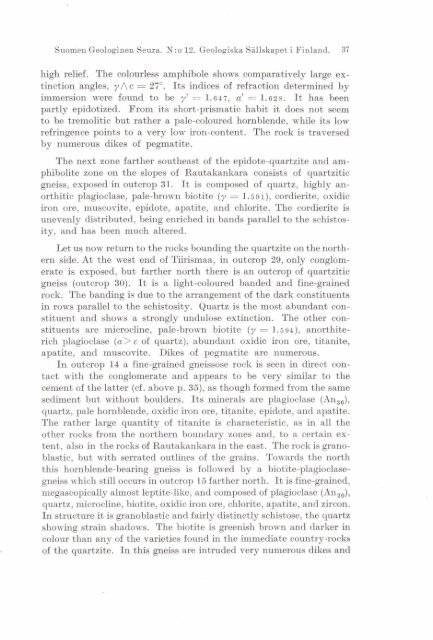GOHMISSION GEOLOGIQVE - Arkisto.gsf.fi
GOHMISSION GEOLOGIQVE - Arkisto.gsf.fi
GOHMISSION GEOLOGIQVE - Arkisto.gsf.fi
Create successful ePaper yourself
Turn your PDF publications into a flip-book with our unique Google optimized e-Paper software.
Suomen Geologinen Seura. N:o 12. Geologiska Sallskapet i Finland. 37<br />
high relief. The colourless amphibole shows comparatively large extinction<br />
angles, y Ac = 27". Its indices of refraction determined by<br />
immersion were found to be y' = 1.647, a' - 1.628. It has been<br />
partly epidotized. From its short-prismatic habit it does not seem<br />
to be tremolitic but rather a pale-coloured hornblende, while its low<br />
refringence points to a very low iron-content. The rock is traversed<br />
by numerous dikes of pegmatite.<br />
The next zone farther southeast of the epidote-quart~ite and amphibolite<br />
zone on the slopes of Rautakankara consists of quartzitic<br />
gneiss, exposed in outcrop 31. It is composed of quartz, highly anorthitic<br />
plagioclase, pale-brown biotite ( y = 1.5 s 1 ), cordierite, oxidic<br />
iron ore, muscovite, epidote, apatite, and chlorite. The cordierite is<br />
unevenly distributed, being enriched in bands parallel to the schistosity,<br />
and has been much altered.<br />
Let us now return to the rocks bounding the quartzite on the northern<br />
side. At the west end of Tiirismaa, in outcrop 29, only conglomerate<br />
is exposed, but farther north there is an outcrop of quartzitic<br />
gneiss (outcrop 30). It is a light-coloured banded and <strong>fi</strong>ne-grained<br />
rock. The banding is due to the arrangement of the dark constituents<br />
in rows parallel to the schistosity. Quartz is the most abundant constituent<br />
and shows a strongly undulose extinction. The other constituents<br />
are microcline, pale-brown biotite (y = 1.594), anorthiterich<br />
plagioclase (a> e of quartz), abundant oxidic iron ore, titanite,<br />
apatite, and muscovite. Dikes of pegmatite are numerous.<br />
In outcrop 14 a <strong>fi</strong>ne-grained gneissose rock is seen in direct contact<br />
with the conglomerate and appears to be very similar to the<br />
cement of the latter (cf. above p. 35), as though formed from the same<br />
sediment but without boulders. Its minerals are plagioclase (An,,),<br />
quartz, pale hornblende, oxidic iron ore, titanite, epidote, and apatite.<br />
The rather large quantity of titanite is characteristic, as in all the<br />
other rocks from the northern boundary zones and, to a certain extent,<br />
also in the rocks of Rautakankara in the east. The rock is granoblastic,<br />
but with serrated outlines of the grains. Towards the north<br />
this hornblende-bearing gneiss is followed by a biotite-plagioclasegneiss<br />
which still occurs in outcrop 15 farther north. It is <strong>fi</strong>ne-grained,<br />
megascopicslly almost leptite-like, and composed of plagioclase (An,,),<br />
quartz, rnicrocline, biotite, oxidic iron ore, chlorite, apatite, and zircon.<br />
In structure it is granoblastic and fairly distinctly schistose, the quartz<br />
showing strain shadows. The biotite is greenish brown and darker in<br />
colour than any of the varieties found in the immediate country-rocks<br />
of the quartzite. In this gneiss are intruded very numerous dikes and
















